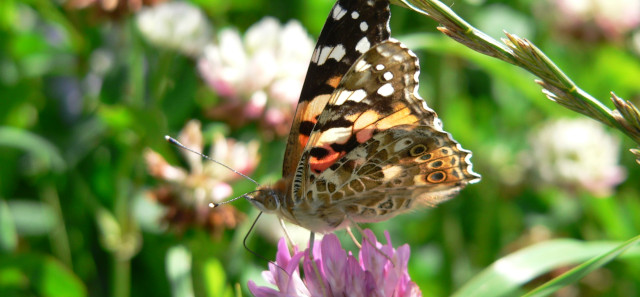How studies in butterflies led to a paradigm shift in conservation
Research at the University of Reading has shaped a new approach in environmental policy-making, to create 21st century landscapes that are fit for wildlife.
The butterfly effect
Biodiversity under threat
The biodiversity of our natural environment has suffered a continual decline in recent decades. This is caused by factors such as habitat loss through intensive land-use, and climate change. As our population grows and the planet warms, conservation strategies must adapt to secure a biodiverse environment for future generations.
The importance of habitat connectivity
Dr Tom Oliver, Associate Professor of Landscape Ecology at the University of Reading, is influencing a new approach to conservation. Using butterflies as an indicator species, Tom’s research has revealed how the range, arrangement and size of habitats within modern landscapes are vital for biodiversity. Small patches of habitat surrounded by hostile conditions – imagine an island of trees in the middle of intensively farmed arable fields – leave species vulnerable when conditions change, for example during drought.
He proposes that restoring the ‘functional connectivity’ of habitats will improve the resilience of butterflies and other populations in the face of threats such as extreme weather events. This means providing ‘corridors’ or stepping stones of meadows, woodland, flower-rich field margins or road verges, to connect larger areas of habitat to each other.
Dr Oliver has also developed a suite of practical measures of habitat connectivity that may become a standard monitoring method for the Joint Nature Conservation Committee, which advises the UK government and Scottish, Welsh and Northern Irish Assemblies.
A paradigm shift
Through his research insights, Dr Oliver has helped to bring about a paradigm shift in conservation thinking – towards landscape-scale approaches. Dr Richard Bradbury, Head of Environment at the RSPB, explains: “Tom’s work has made an important contribution to shaping environmental and conservation policy and practice in the UK. It has underpinned the drive to move beyond just protected areas and consider whole-landscape conservation, which is of great international importance.”
This is illustrated in UK Government’s 25 Year Environment Plan, published in 2018. It quotes a seminal work by Sir John Lawton that drew from Dr Oliver’s research in calling for ‘more habitat; in better condition; in bigger patches that are more closely connected.’
Evidence for protection
Thanks to experts like Dr Oliver, action is being taken to improve and protect biodiversity in the UK. For example, twelve Government-backed Nature Improvement Areas have already been established. These include a project to reinstate open moorland habitat and oak woodland in the Peak District, the restoration of linked habitats across more than 1,000 hectares of wooded valleys and water courses in North Devon and the protection of Britain’s third largest lowland raised bog in the meres and mosses of Shropshire and the Welsh Marches
Further information
Dr Oliver research continues to generate compelling ecological evidence that informs and influences environmental policy-making nationally and internationally.
Dr Oliver’s Staff Profile. Twitter @Tom_H_Oliver
Major funders: Natural England, NERC
References and further reading
Oliver, T., Roy, D.B., Hill, J.K., Brereton, T. & Thomas, C.D. (2010). Heterogeneous landscapes promote population stability. Ecology Letters, 13, 473-484. doi: 10.1111/j.1461-0248.2010.01441.x.
Oliver, T. H., Marshall, H. H., Morecroft, M. D., Brereton, T., Prudhomme, C. and Huntingford, C. (2015) Interacting effects of climate change and habitat fragmentation on drought-sensitive butterflies. Nature Climate Change, 5 (10). pp. 941-945. ISSN 1758-678X doi: https://doi.org/10.1038/nclimate2746
Oliver, T., Powney, G. D., Baguette, M. and Schtickzelle, N. (2017) Synchrony in population counts predicts butterfly movement frequencies. Ecological Entomology, 42 (3). pp. 375-378. ISSN 0307-6946 doi: https://doi.org/10.1111/een.12391
Sir John Lawton (2010) Making Space for Nature. DEFRA

